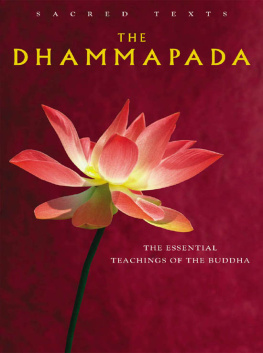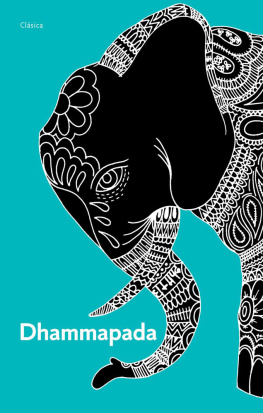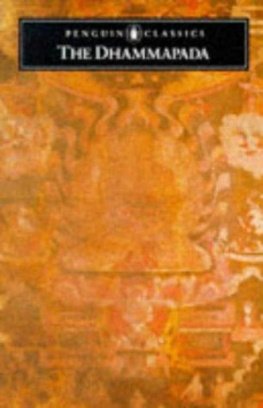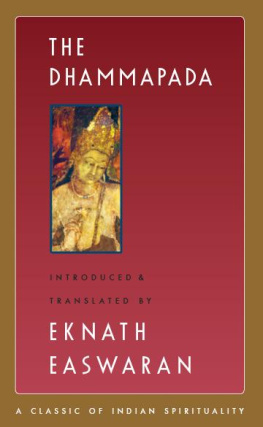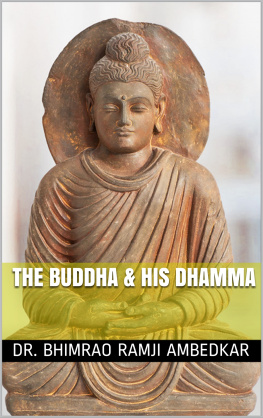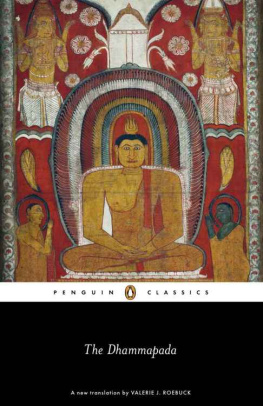G. Buddha - The Dhammapada
Here you can read online G. Buddha - The Dhammapada full text of the book (entire story) in english for free. Download pdf and epub, get meaning, cover and reviews about this ebook. year: 1936, publisher: New Directions, genre: Science. Description of the work, (preface) as well as reviews are available. Best literature library LitArk.com created for fans of good reading and offers a wide selection of genres:
Romance novel
Science fiction
Adventure
Detective
Science
History
Home and family
Prose
Art
Politics
Computer
Non-fiction
Religion
Business
Children
Humor
Choose a favorite category and find really read worthwhile books. Enjoy immersion in the world of imagination, feel the emotions of the characters or learn something new for yourself, make an fascinating discovery.
The Dhammapada: summary, description and annotation
We offer to read an annotation, description, summary or preface (depends on what the author of the book "The Dhammapada" wrote himself). If you haven't found the necessary information about the book — write in the comments, we will try to find it.
The Dhammapada — read online for free the complete book (whole text) full work
Below is the text of the book, divided by pages. System saving the place of the last page read, allows you to conveniently read the book "The Dhammapada" online for free, without having to search again every time where you left off. Put a bookmark, and you can go to the page where you finished reading at any time.
Font size:
Interval:
Bookmark:

Irving Babbitt, born in Dayton, Ohio, in 1865, graduated fromHarvard with honors in 1889. He studied Sanskrit language and Indian philosophyunder Sylvain Lvi at the cole des Hautes tudes, Paris, and thenreturned to Harvard for his M.A. (1893). In 1894 he became a French teacher atHarvard and was made a full professor in 1912; he remained there until his death in1933. Despite his lifelong interest in the language and thought of the East, henever visited the Orient, though his wife was born and brought up in China. Duringhis last illness, he worked on The Dhammapada, but never completed the notes. The book was publishedposthumously.
Babbitt published seven books: Literature and the American College:Essays in the Defense of the Humanities (1908); The New Laokoon(1910); The Masters of Modern French Criticism (1912); Rousseau and Romanticism (1919); Democracy and Leadership (1924); On Being Creative and OtherEssays (1932); and The Dhammapada (1936). A second posthumous volume, Spanish Character and Other Essays, appeared in 1940.
With Paul Elmer More, Babbitt was a leading exponent of what came tobe called the New Humanism, which still has many echoes in present-daycriticism. Among those who studied under and were strongly influenced by Babbittwere T. S. Eliot, Norman Foerster, Van Wyck Brooks, Austin Warren, and TheodoreSpencer; other students less directly his disciples were Walter Lippmann, GilbertSeldes, Newton Arvin, Harry Levin, Granville Hicks, and Crane Brinton.
This is not a doctrine for the sluggard but for the man whoputs forth virile effort.
Anguttara-Nikya, IV, p. 232.
The Tathgata has no theories.
Majjhima-Nikya, I, p. 486.
T HE word Dhammapada may perhaps best be rendered Path of Virtue, provided one keep in mind that virtue means practically the Buddhist Law or Norm. According to the usual arrangement it appears as the tenth division of the Khuddaka-nikaya, itself the fifth division of the Suttapitaka, the second of the three baskets (Ti-pitaka) that constitute the Buddhist Canon as preserved by the Theravins or School of the Elders. The Canon thus constituted is accepted today in Ceylon, Burma, Siam, etc., in short in the lands where the form of Buddhism known as the Small Vehicle (Hnayna) prevails. The language of the Ti-pitaka is Pli, supposed to have been the dialect spoken in the province of Magadha in northeastern India about the sixth century before Christ. Pli is a sort of softened Sanskrit; its relation to Sanskrit has indeed been compared to that of Italian to Latin. Nirvna, for example, becomes nibbna, bhikshu (monk) bhikkhu, etc. I have not hesitated to use the Sanskrit instead of the Pli form when it happens to be more familiar to the Western reader.
Some portions of the Ti-pitaka are in prose, some in verse, and others in a mingling of the two. The Dhammapada is entirely in verse. The four hundred and twenty-three stanzas of which it is composed are in various metres, all related to the verse form in Sanskrit known as the loka
The relation of the Pli Canon in its present form to the original teaching of Buddha, on the one hand, and, on the other, to the scriptures of other schools of Buddhism in Sanskrit, Thibetan, Chinese, etc., raises questions of extreme complexity. Anyone who seeks fuller information regarding these questions may consult with profit the volume by E. J. Thomas, The Life of Buddha as Legend and History. The attitude of Mr. Thomas towards Buddhism reminds one of that of the higher critics towards Christianity. It is well to remember in regard to this attitude that it is often as extreme in its way as the uncritical acquiescence of the orthodox Buddhist or Christian in tradition. Practically all scholars who have earned the right to have an opinion now admit, not only that Buddha actually lived, but that he taught the four noble truths. This is to admit a great deal, for the Ti-pitaka is in large measure simply a dialectical development of these truths. The fact is that one cannot read long in the Pli records without getting the impression of a definite doctrine and a definite personality. For the personality of Buddha, which seems to many even more impressive than the doctrine, one needs to turn from the Dhammapada to other portions of the Canon, especially perhaps to certain Suttas of the Dgha-nikya. Doctrinally, however, there is no reason to doubt that most of the verses of the Dhammapada, even if they do not reproduce the ipsissima verba of Buddha, are true to the spirit of his teaching. The Buddhists themselves recommend the collection for those who wish to get an initiation into the faith that is sound as far as it goes.
The present translation is a revision of the one first published by Max Mller in 1870 and later included in the tenth volume of the Sacred Books of the East (first edition, 1881; second edition, 1898). I have aimed to depart as little as possible from the literal sense, even though this literalness has involved at times some sacrifice of elegance. It should be added that there is a formidable obstacle in the way of any rendering of a Buddhist text that will not be misleading, and that is the existence of numerous general terms in Pli that have no exact equivalent in English or any other Occidental language. One way of meeting the difficulty would have been to append to the present translation short essays on such terms as dhamma, samkhra, khanda, sava, tanh, nma-rpa and the like. My decision not to write these essays is due to the conviction that the only way to grasp fully the meaning of these terms is to gain a wider acquaintance with the Pli Canon than that afforded by the Dhammapada. Even so it is difficult, for reasons which I have tried to state in Buddha and the Occident, for the Occidental, even the Occidental who has read the texts widely in the original, to catch life from the Buddhist angle.
In revising Max Mllers version I have consulted with profit the text (with Latin translation) by Fausbll (first edition, 1855; second revised edition, 1900); and the edition of the Pli text published by the Pli Text Society and edited by Suriyagoda Sumangala Thera (1914). I have consulted the German verse translation by K. E. Neumann (1893), the English verse translation by F. L. Woodward (1921), and the prose rendering by W. D. C. Wagiswara and K. J. Saunders in the Wisdom of the East Series (1920). I have also profited by the portions of the Dhammapada Commentary translated by E. W. Burlingame for the Harvard Oriental Series (three volumes, 1921).
Finally I wish to express my obligations to my old teachers, Sylvain Lvi, Professor of Sanskrit at the Collge de France, and to Charles Rockwell Lanman, Professor emeritus of Sanskrit at Harvard University. I scarcely need add that they are not to be held in the least responsible for my interpretation of Buddhism and still less for any inaccuracies into which I may have fallen through an inadequate knowledge of Pli.
| 1. | All that we are is the result of what we have thought: it is founded on our thoughts, it is made up of our thoughts. If a man speaks or acts with an evil thought, pain follows him, as the wheel follows the foot of the ox that draws the wagon. |
| 2. | All that we are is the result of what we have thought: it is founded on our thoughts, it is made up of our thoughts. If a man speaks or acts with a pure thought, happiness follows him, like a shadow that never leaves him. |
Font size:
Interval:
Bookmark:
Similar books «The Dhammapada»
Look at similar books to The Dhammapada. We have selected literature similar in name and meaning in the hope of providing readers with more options to find new, interesting, not yet read works.
Discussion, reviews of the book The Dhammapada and just readers' own opinions. Leave your comments, write what you think about the work, its meaning or the main characters. Specify what exactly you liked and what you didn't like, and why you think so.



